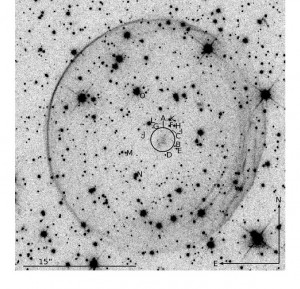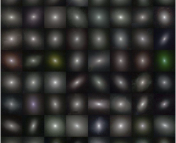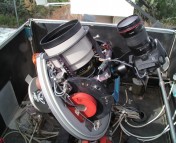• Paper title: The center of the Type Ia supernova remnant SNR 0509-67.5 is empty of any ex-companion star to MV=+8.4
• Authors: Bradley E. Schaefer & Ashley Pagnotta
• First author’s affiliation: Department of Physics and Astronomy, Louisiana State University
Type Ia supernova receive a lot of attention, not only on Astrobites, but in astronomy in general. These transient events are extremely bright and relatively uniform, making them excellent standard candles on cosmological scales, so much so that the 2011 Nobel Prize in Physics was awarded to the astronomers who used type Ia supernovae to measure the accelerating expansion of the universe.
While we already know these explosions are close to the same absolute brightness, we want to know exactly how uniform these transients are. Identifying the progenitor systems of type Ia supernovae lies at the heart of this issue. We know these thermonuclear explosions occur in a binary system, of which one member is a carbon oxygen white dwarf (COWD). White dwarfs are supported by electron degeneracy pressure, and as a result can only grow up to the Chandrasekhar mass limit. In a type Ia event, a COWD exceeds this mass by accreting matter from a companion star, and thus begins to collapse. Because carbon and oxygen still have a lot of energy to release owing to nuclear reactions, the high temperatures and pressures of the collapsing white dwarf lead to explosive ignitions of these elements, and ultimately result in the disruption of the entire star.
However, almost certainly, the nature and amount of the mass accreted from the companion affects the explosion properties. There are two suggested scenarios for the progenitor system for Type Ia events. The first is called the single-degenerate scenario. In this scenario, the companion star is either a main sequence or red giant star which donates some of its envelope (mostly hydrogen) to the COWD. The second model is the double-degenerate scenario, where the companion is also a (degenerate) white dwarf. In this case, the explosion happens via a merger of the two, and both white dwarfs will be destroyed in the explosion.
One way to distinguish between the two scenarios is to look for the companion star in a known type Ia supernova remnant — if a main sequence or red giant companion can be identified, that points to the single-degenerate scenario. The authors of this paper examine SNR 0509-67.5, a type Ia supernova that occurred around 400 years ago in the Large Magellanic Cloud. This has been previously determined using light echoes. While the details of how this is done are outside of the scope of this post, you should definitely check out Maria’s post for a great review of how astronomers use light echoes.

Figure 1 of Schaefer & Pagnotta: The Hα image shows the supernova remnant 0509-67.5. The error circle used for the ex-companion search is shown. There are no stars found within the error circle, however, several stars of interest are marked with letters. Their direct properties can be found in table 2 of Schaefer & Pagnotta; however, the authors note that their error circle is conservative, and none of these stars are likely to be the ex-companion.
Since this explosion was only 400 years ago, if a companion survived the explosion, as is expected for the single-degenerate scenario, it will still reside near the center of the remnant. So the first step in this work is to identify the geometric center of the remnant. Schaefer & Pagnotta do so using three independent methods:
(1) the edge of the shell in the Hα waveband. To do this, the authors assume that the blast wave has traveled in a straight path out from the explosion point, and thus they can pinpoint the explosion location by finding the line currently perpendicular to the blast wave and finding where it bisects with other such line segments.
(2) the edge of the shell in the X-ray waveband. This works in the same manner as method (1).
(3) the Hα minimum in the remnant. The minimum is expected to be near the explosion site because the blast wave would’ve been quite dense at that point, and thus more likely to sweep up material in the medium.
After finding the geometric center of the image, the authors perform searches for possible ex-companion in that area. They are able to narrow down exactly where such a star should lie, since even if it is moving quickly, it has only had about 400 years to move away from the explosion point. Schaefer & Pagnotta find no potential ex-companion to a limit of V=26.9 magnitude (MV=+8.4). This finding rules out all published single-degenerate models, and thus supports the double-degenerate scenario for this remnant.
This may not be the case in all remnants however. In 2004, Ruiz-Lapuente et al presented a potential ex-companion in Tycho’s supernova remnant. I should note that this finding has been controversial, and the claim has not been settled either way (González Hernández et al). There is also some evidence suggesting both scenarios arise. If you are interested in type Ia supernovae and their progenitor systems, you should definitely check out the two part series on SN2011fe (one of the closest nearby supernovae in recent years!) by Elizabeth and Michelle if you haven’t already.





Trackbacks/Pingbacks